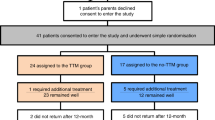Abstract
Background
Infantile haemangioma is a common benign tumour of infancy. Ulceration is the most common complication and is often painful and difficult to treat. Propranolol therapy is widely used to induce involution in rapidly growing or ulcerated lesions, or those in anatomically awkward locations. The ideal dressing regimen for these lesions would provide effective analgesia, act as a wound dressing, and aid involution of the primary lesion. To date, no ideal regimen has been established. Negative pressure wound therapy (NPWT) has been used in adult and paediatric populations to help improve wound healing in a variety of settings. It may provide a useful alternative to traditional dressing regimens in ulcerated infantile haemangioma.
Methods
Six consecutive patients with ulcerating infantile haemangioma presenting to the Royal Children’s Hospital vascular anomalies clinic were included in the study. Each patient was treated with a combination of NPWT and propranolol. Outcomes including time to wound healing, perceived ease of dressing management, and analgesia were recorded.
Results
Complete wound healing was obtained in all cases. Patient outcomes in terms of analgesia, comfort, and ease of wound dressing were improved following application of NPWT.
Discussion/Conclusions
We propose that this regimen represents a novel therapy for management of ulcerated infantile haemangioma. Possible mechanisms for healing effect, and improved analgesia are discussed. Further investigation is required to determine if negative pressure wound therapy results in faster healing times compared to traditional dressing regimens.



Similar content being viewed by others

References
Jacobs AH (1956) Strawberry hemangiomas; the natural history of the untreated lesion. Calif Med 86(1):8–10
Léauté-Labrèze C, Prey S, Ezzedine K (2011) Infantile haemangioma: part I. Pathophysiology, epidemiology, clinical features, life cycle and associated structural abnormalities. J Eur Acad Dermatol Venereol 25:1245–1253
Drolet BA, Esterly NB, Frieden IJ (1999) Hemangiomas in children. N Engl J Med 341(3):173–181
Maguiness SMS, Frieden IJI (2012) Management of difficult infantile haemangiomas. Arch Dis Child 97(3):266–271
Zimmermann APA, Wiegand SS, Werner JAJ, Eivazi BB (2010) Propranolol therapy for infantile haemangiomas: review of the literature. Int J Pediatr Otorhinolaryngol 74:338–342
Chamlin SL, Haggstrom AN, Drolet BA, Baselga E, Frieden IJ, Garzon MC et al (2007) Multicenter prospective study of ulcerated hemangiomas. J Pediatr 151:684–689
Matatov TT, Reddy KNK, Doucet LDL, Zhao CXC, Zhang WWW (2013) Experience with a new negative pressure incision management system in prevention of groin wound infection in vascular surgery patients. J Vasc Surg 57:791–795
Vargo DD (2012) Negative pressure wound therapy in the prevention of wound infection in high risk abdominal wound closures. Am J Surg 204:1021–1024
Grauhan O, Navasardyan A, Hofmann M, Müller P, Stein J, Hetzer R (2013) Prevention of poststernotomy wound infections in obese patients by negative pressure wound therapy. J Thorac Cardiovasc Surg 145:1387–1392
Armstrong DG, Lavery LA, Consortium DFS (2005) Negative pressure wound therapy after partial diabetic foot amputation: a multicentre, randomised controlled trial. Lancet 366:1704–1710
Choi W, McBride C, Kimble R (2011) Negative pressure wound therapy in the management of neonates with complex gastroschisis. Pediatr Surg Int 27:907–911
Léauté-Labrèze C, Prey S, Ezzedine K (2011) Infantile haemangioma: part II. Risks, complications and treatment. J Eur Acad Dermatol Venereol 25:1254–1260
Koh C, Sugo E, Wargon O (2009) Unusual presentation of GLUT-1 positive infantile haemangioma. Australas J Dermatol 50(2):136–140
Morais P et al (2014) Reticular hemangioma of the lower extremity associated with congenital structural anomalies: therapeutic approach. Med Cutan Iber Latin Am 41(1):38–42
Léauté-Labrèze C et al (2008) Propranolol for severe hemangiomas of infancy. N Engl J Med 358:2649–2651
Hermans D, Boezeman J, Van de Kerkhof P, Rieu P, Van der Vleuten C (2009) Differences between ulcerated and non-ulcerated hemangiomas, a retrospective study of 465 cases. Eur J Dermatol 19:152–156
Hunter J, Teot L, Horch R, Banwell P (2007) Evidence-based medicine: vacuum-assisted closure in wound care management. Int Wound J 4:256–269
Morykwas M, Argenta L, Shelton-Brown E, McGuirt W (1997) Vacuum-assisted closure: a new method for wound control and treatment: animal studies and basic foundation. Ann Plast Surg 38:553–562
Kamolz L et al (2004) Use of subatmospheric pressure therapy to prevent burn wound progression in human: first experiences. Burns 30:253–258
Greene A et al (2006) Microdeformational wound therapy: effects on angiogenesis and matrix metalloproteinases in chronic wounds of 3 debilitated patients. Ann Plast Surg 56:418–422
Wackenfors A et al (2003) Effects of vacuum-assisted closure therapy on inguinal wound edge microvascular blood flow. Wound Repair Regen 12:600–606
Mouës C, Vos M, van den Bemd G, Stijnen T, Hovius S (2003) Bacterial load in relation to vacuum-assisted closure wound therapy: a prospective randomized trial. Wound Repair Regen 12:11–17
Chen SZ, Li J, Li XY, Xu LS (2005) Effects of vacuum-assisted closure on wound microcirculation: an experimental study. Asian J Surg 28:211–217
Morykwas M, Faler B, Pearce D, Argenta L (2001) Effects of varying levels of subatmospheric pressure on the rate of granulation tissue formation in experimental wounds in swine. Ann Plast Surg 47:547–551
Hein K, Mulliken J, Kozakewich H, Upton J, Burrows P (2002) Venous malformations of skeletal muscle. Plast Reconstr Surg 110:1625–1635
Author information
Authors and Affiliations
Corresponding author
Rights and permissions
About this article
Cite this article
Fox, C.M., Johnson, B., Storey, K. et al. Negative pressure wound therapy in the treatment of ulcerated infantile haemangioma. Pediatr Surg Int 31, 653–658 (2015). https://doi.org/10.1007/s00383-015-3716-x
Accepted:
Published:
Issue Date:
DOI: https://doi.org/10.1007/s00383-015-3716-x



